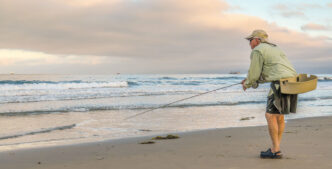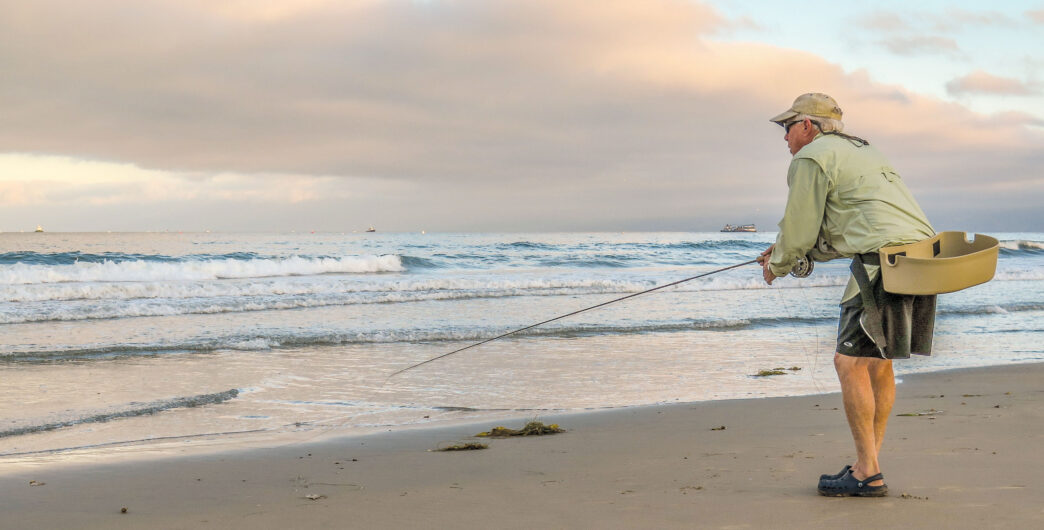When the purple flowering jacaranda begin to bloom in Southern California, it usually means that the elusive corbinas (aka the “beans,” “sliders,” “frijoles”) are beginning to become active along the majestic, shallow shores. The California corbina (Menticirrhus undulates) is a member of the croaker family and inhabits the inshore coastal beaches from Santa Barbara down to Magdalena Bay in Baja, Mexico. They typically run from two to five pounds, although I have seen some pushing seven. They are most active in the shallow tidal zones from June through August and can often be seen with their backs half out of the water as they slide up and down the beach in less than a foot of water, searching for their favorite food, the mole or sand crab. It is during this time that many of my comrades, affectionately known as the Corbina Patrol, are also roaming these same beaches, fly rods at the ready, in hopes of sight-casting a sand crab imitation to a willing bean. It’s my favorite time of the year.
Many fly anglers new to this game can easily get frustrated trying to sight cast to these wary fish, and I don’t blame them — I am included in this group. Let’s face it: you are trying to drop a fly on a moving target in skinny water with lots of variables, such as waves and, sometimes, crowds at the beach. Corbinas don’t always cooperate. They can be finicky and require accurate casts in constantly changing environments, but that’s what makes this game fun and what will make you a better angler. I will try to pack in as much information as I can here to ensure you are both dangerous and more confident when you go after these wonderful fish.
Have the Right Equipment
During the late spring and early summer, we begin to see decreasing ocean swells and calm winds along the Southern California coast. These conditions allow fly anglers to switch to lighter fly rods in the surf. You can easily downsize your gear to a 5-weight, 6-weight, or 7-weight rod. A lightweight reel with 150 yards of 20-pound-test Dacron backing is all you will need. If you can afford to get a reel with a closed-drag system, it will make your fishing more enjoyable, especially if you accidentally drop your reel in the water or decide to lay your outfit down on the sand to take a picture. A 200-grain integrated shooting head (an example is the Rio Outbound T-8), cut back to 27 feet, works great. A sinking line will track straight. What’s most important is that you stay in direct contact with the end of the line and your fly, or you are out of the game, because a corbina can eat and then spit out a fly before you ever feel the take. Staying tight to the fly and consistently moving it will allow you feel any tick. There are times in very shallow conditions when a clear intermediate line will work well, but only if there is very little side current, otherwise it is difficult to stay connected to the fly. As far as a tippet or leader system goes, you can use a tapered leader for a delicate presentations or just keep it simple and use a straight 7-foot to 8-foot piece of 10-pound to 15-poundtest fluorocarbon. Use a Nonslip Mono Loop knot to your fly. It helps add movement and sinks the fly faster. Most fish are not leader shy in the surf zone, so using a heavier leader will also help you land the fish sooner.

Be Able to See the Fish
Polarized glasses are a necessity for sight fishing. There are many fine brands on the market. If you are fishing in early, low-light, or overcast conditions, a yellow lens is a great choice. A brown or amber lens will be fine on sunny days. Wear a wide-brimmed hat to shade your eyes, and apply a black marking pen under the brim to help deflect reflection and make looking for fish easier on your eyes.
Practice Your Casting
This sounds obvious, but many anglers practice casting with a floating line and a piece of yarn. For sight fishing, this will not cut it. When practicing, use the same fly you plan to fish, and cut off the hook, then make sure to use the same length leader every time. Being consistent with your setup will help your accuracy and give you confidence when you have to put the fly right on the fish or make a change-of-direction cast. Sight fishing is a game of inches, and accuracy will pay off.
Have the Right Fly, Sharp Hook
If you are new to this game, take my advice and put on a Surfin’ Merkin in gray or salmon pink. A lot of anglers often change their flies, assuming it’s the fly that’s not working. Trust me: the Surfin’ Merkin works — you just need to get it in front of the bean. The Surfin’ Merkin was adapted from a Del Brown permit pattern by my good friend Paul Cronin from Oxnard. This fly lands softly, and stripped along the sand, it pushes water and looks like a real sand crab leaving a V wake in its path. We tie them with EP Fibers in light gray or salmon pink on a Gamagatsu SL11-3H or B10S Stinger hooks in sizes 8, 6 and 4. Tie them with various weights of Dazl Eyes from 5/32 to 1/8 ounce to adapt to different water levels. The fly needs to be on the sand and stripped along the bottom to be effective.

Understand Fish Behavior
Understanding f ish behavior will help you make your best presentation. In the early summer months, we like to focus on early-morning minus tides. There are a few reasons for that. The beaches are less crowded, you have low light to your advantage to avoid spooking fish, and the fish are hungry, having to wait for the water to rise over the flat sand to eat. During the incoming tide cycle, you will see corbinas coming straight up the beach to dive-bomb the crab beds, after which they turn and slide back to safety.
Once the water gets up on the f lat and covers the beds, you may enter what I call the “magic window.” It usually lasts 20 to 40 minutes. It is the perfect time — there is enough water on the f lat to see fish do tail flips and cartwheels with their noses down. It is the apex of feeding and a great opportunity to connect with a fish on a well-presented fly. Be in the right place at the right time, and the magic window will open.
Once the water begins to rise about one to two feet over the crab beds, the corbinas calm down and begin to cruise parallel to beach. When this happens, stay far back and run to get way out in front of them before attempting a cast. These are cruising fish, and they will take a f ly, but your casts must be perfect — either a 45-degree shot or dropped right in front of their noses without spooking them. If a fish wants your fly, it will track it and kill it. If you see the fish turn on the fly, do not stop stripping until you go tight to the fish, and set the hook by moving sideways, keeping your rod pointed straight at the fish. Do not set as you would with trout!
Locate Crab Beds
Get down to the beach on a minus tide to see where the crab beds are. Look for sandpipers or curlews — they are a sure bet that crabs are present. The crab beds move around, so it is important to know their location. Once the fish find these beds on the rising tide, they tend to make repeat visits. Stake out a good piece of real estate and wait.
Understand the Conditions for Sight Fishing
Sunny days are best for sight fishing, especially if the sun is at your back and you are out early. Look at the weather and satellite images to determine windows of sunshine. Avoid foggy and cloudy days — it is tougher to see fish and can be frustrating. If you can’t see them, you can’t catch them unless you blind cast. And find beaches that are f lat. Their gentle slope makes it easier to see fish.

Learn to Land Fish in the Surf
Set a light drag and use the palm of your hand to add drag tension, if you need it. When a fish eats, let it take a long first run, then begin to apply some pressure.
Change rod angles and use side pressure. Allow the waves to help you reel faster when the fish is coming toward you. If the fish turns, let it go where it wants, but stay tight. When the fish tires, surf him in using the waves to your advantage.
The Code Has Been Cracked
Over the past decade or so, I have seen hundreds of corbinas sight fished and fair caught in the surf by fly anglers. The corbina code has been cracked, and if you are willing to put in the time and effort, you, too, can be successful at sight fishing for corbinas in skinny water. And these same skills, once mastered, can be used anywhere in the world in pursuit of other wary shallow-water species on the fly. I put sight casting to corbinas right up there with sight casting for permit, carp, stripers, or bonefish, and I have done them all.
This is perhaps one of the most challenging and rewarding games we have on the Southern California coast during the early summer months. It is the most fun you can have with a fly rod.


















